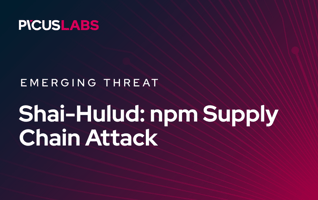From Alert Fatigue to Action: SOC Optimization in Healthcare
IT infrastructure has become the backbone of healthcare organizations, and the burden of defending these systems falls heavily on Security Operations Centers (SOCs). Yet too many healthcare SOC teams are fighting an uphill battle, one riddled with high alert volumes, limited visibility, and the constant pressure to maintain uninterrupted patient care while ensuring regulatory compliance.
Healthcare SOC teams are expected to detect, triage, and respond to threats in real time. However, with the growing frequency and sophistication of attacks and a near-constant attacker focus on the healthcare industry, their job has, like a death from a thousand cuts, gradually become unmanageable. Without the right tools and processes, SOCs often fall into a reactive cycle of chasing alerts, trying to make sense of incomplete information, and struggling to prove the effectiveness of their defenses. To break this cycle, more healthcare organizations are embracing automation through Breach and Attack Simulation (BAS) to proactively shift from alert fatigue and burnout to actionable insights leading to optimized operations.
Looking for a BAS solution? Check out our Free Trial and See Picus in Action
Why Healthcare SOCs Are Stretched So Thin
Healthcare SOCs face a unique combination of challenges. Their environments are dynamic and high-risk and often represent the worst of both worlds, in a way, using outdated legacy systems against attacks on modern clouds and digital health platforms. On any given day, a single hospital may be running dozens of third-party systems, thousands of endpoints, and hundreds of connected devices, all of which have to be continuously monitored for threats without disrupting care.
One of the most persistent challenges healthcare security teams face is alert fatigue. Tools like EDRs and SIEMs generate massive volumes of alerts every day. Many of these are false positives, while others lack the context teams need to effectively triage them. As a result, analysts waste valuable time chasing non-issues, while real threats risk going undetected. The constant flood of data erodes confidence, slows response times, and, day in and day out, quickly leads to burnout.
Making matters worse is the lack of continuous visibility into how well security controls are working. Just because a tool is deployed doesn't mean it's detecting or blocking threats as expected. Controls go misconfigured. Rules become outdated. And without real-world testing, these blind spots persist, giving attackers room to operate in your environment undetected.
Another critical issue is limited operational capacity. Many healthcare SOCs are understaffed, small teams tasked with defending large, distributed infrastructures. Staff shortages, skills gaps, and high turnover, especially in regional or underfunded facilities, can make it difficult to maintain consistent monitoring and response capabilities. Add to this the documentation needs to maintain compliance with frameworks like HIPAA, HITRUST, and ISO 27799, and it's no surprise that so many healthcare SOC teams are essentially fried.
Yet amid all this complexity, one thing remains constant. Time. Whether it's containing a ransomware infection or responding to an exfiltration attempt, every second counts. The sooner a threat is identified, verified, and remediated, the less likely it is to impact patient care, safety, data, and trust.
How BAS Helps SOC Teams Move from Reactive to Proactive
Now, the good news. Breach and Attack Simulation solutions like Picus BAS give SOC teams the ability to continuously and automatically validate their existing defenses against real-world threats. Rather than waiting for an incident to occur or relying on annual penetration testing, SOC teams can continuously simulate how attackers operate across the cyber kill chain and see exactly how their tools and processes respond.
Breach an Attack Simulation reintroduces clarity back into the equation. With BAS, rather than chasing alerts, SOC teams can continuously test their defenses against real-world threats in a safe, controlled, and automated manner. Teams can clearly see whether their controls detect, respond to, and control these behaviors as expected. If a critical step in the attack chain is missed, your SOC team will know exactly where the gap is and can proactively make the fix on their own terms, with no network actually breached, guesswork needed, or alert overload involved.
BAS also bridges the red and blue team gap. In many healthcare organizations, SOCs lack the in-house resources to run realistic red team exercises or advanced threat simulations. BAS automates these attack scenarios, making it possible for lean teams to emulate adversaries without needing specialized skills, training, or more staff. The platform safely tests both detection and prevention controls in live environments, ensuring that your SOC knows exactly which techniques you're blocking, logging, or detecting.
One of BAS's most powerful aspects is giving you and your teams actual, concrete, actionable output. Instead of simply spitting out more alarms, it delivers vendor-specific prevention signatures and detection rules tailored to your existing security stack. This allows your SOC analysts to quickly update configurations, tune detections, and close security gaps based on evidence, not theory. And your team can often make these changes in hours instead of days or weeks without the added pressure of an active breach, allowing clearer decision-making and a faster, smoother, far less costly path to resolution.
Results That Matter: What Healthcare SOCs Gain with BAS
For healthcare SOC teams, the benefits of implementing a BAS platform are both measurable and immediate. Most notably, SOC teams can have far greater confidence in their detection and response capabilities. Instead of relying on assumed coverage, they can operate with verified assurance that their systems will detect and block known threats. This shift leads to stronger incident response performance and greater situational awareness.
BAS also directly addresses the insidious and ever-present problem of alert fatigue. By focusing the SOC team on real-world simulations and missed detections, you'll spare your analysts the need to examine thousands of alerts with unclear or incomplete context. BAS transforms reactive workflows into proactive ones, where effort can be redirected to fixing high-impact gaps, not chasing ghosts and meaningless alert noise.
After deploying BAS, large hospital systems and national healthcare insurers report significantly improved SOC maturity. By regularly simulating ransomware and APT scenarios, they've improved coordination, playbook effectiveness, and decision-making under pressure. These simulated scenarios serve as both training and real-world exercises, ensuring SOC analysts are ready when a true incident occurs.
All the while, BAS is enhancing your operational efficiency through automation. Continuous security validation runs in the background with little intervention, and your teams receive recurring reports highlighting regressions, new exposures, or progress over time, allowing them to monitor trends and prove ROI without additional headcount.
Transforming Healthcare SOCs with Breach and Attack Simulation
Healthcare security operations can certainly be challenging, but they don't have to be chaotic. With the growing volume of threats, the complexity of hybrid environments, and the pressure to comply with strict regulations, healthcare SOCs finally have a tool that actually makes their lives easier.
Breach and Attack Simulation gives healthcare organizations a powerful, cost-effective way to optimize their SOCs, not by adding more alerts or tools but by automating validation, surfacing what matters, and helping teams act faster. For security teams tired of alert fatigue, endless guesswork, and reactive firefighting, now is the time to shift from noise to knowledge, from snapshots to continuous assurance, and from fatigue to action.








